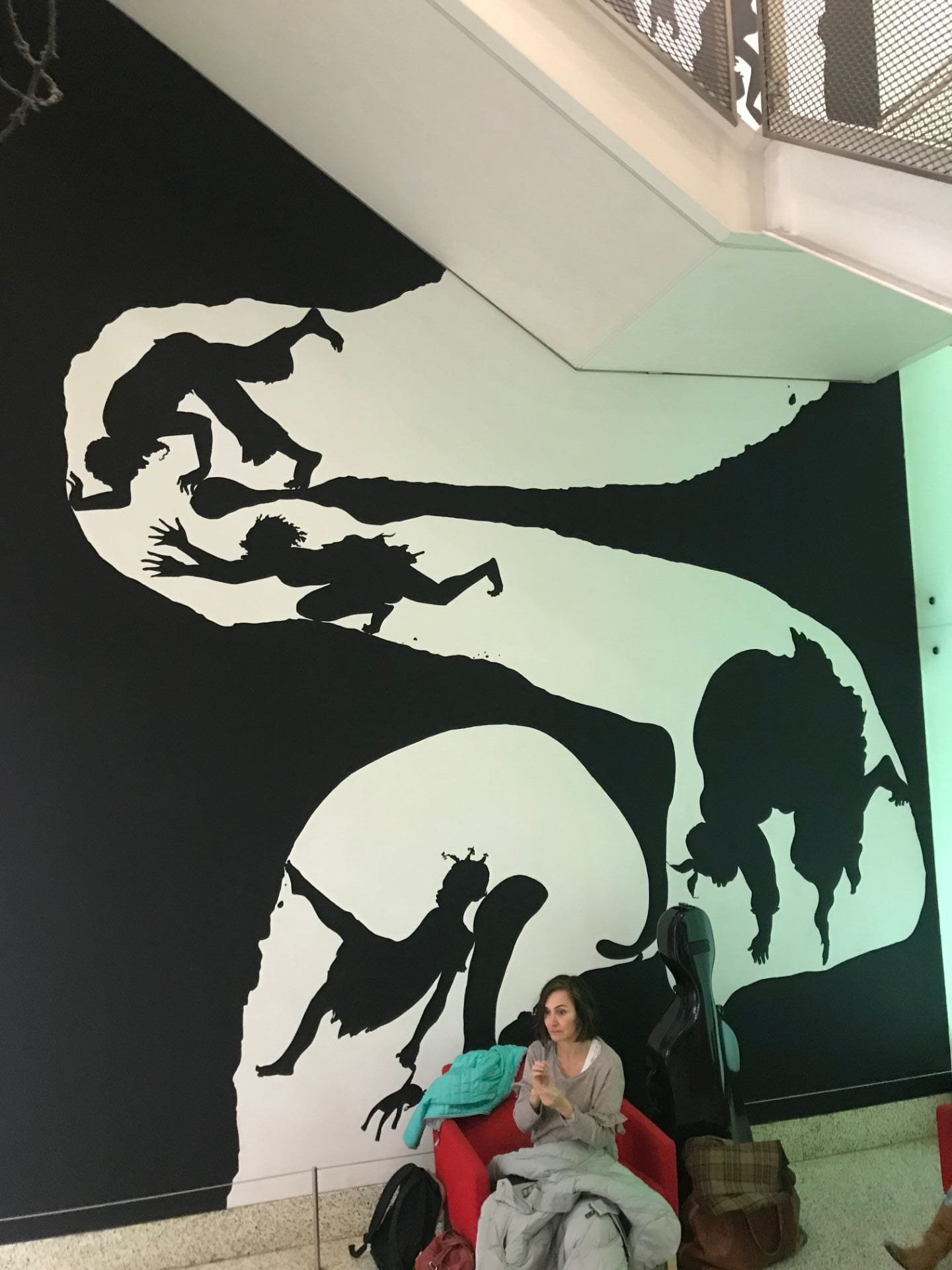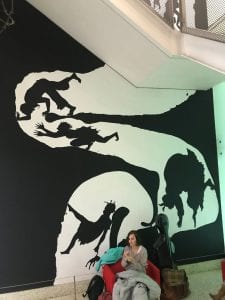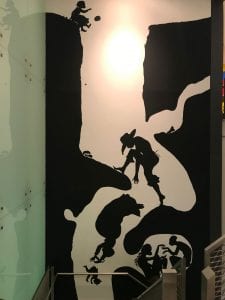Kara Walker’s Event Horizon, commissioned by the Committee for the University Art Collection in 2005, is located in 55 West 13th Street, also known as Arnold Hall. The murals cover two walls, from the floor up to the ceiling, on either side of the flight of stairs leading up to the second floor of the building. Kara Walker utilizes silhouettes, primarily black and white. The medium the artist uses is latex paint. The black silhouettes resemble those used in the mid-18th and early 19th century to create profile portraits or shadow puppetry. Walker paints large burrows, tunnels in the ground commonly made by small animals like rabbits or gophers. In the mural to the left, which is divided by the stairs, a hunched man raises a whip above his head as he chases after a woman who is tumbling into the mouth of the burrow. In the second half of the mural a boy is crawling deeper into the hole where he is met by a girl who is crawling towards him with her hands outstretched. Further into the burrow is an older woman who looks as if she is crouched, ready to dive. The next figure is a girl curled up with her knees to her chest. At the end of the tunnel is another young girl balancing on the walls with a doll in her hand. The mural opposite also depicts a large burrow. At the top, a little girl sits at the opening of the hole with her legs dangling over the edge. She tosses something that resembles a human heart into the burrow. Below her, a figure with a hat is climbing upward, one hand reaching down in the direction of a woman falling head first who also has her arms outstretched toward a small child. The woman’s wrists are bound by rope. To the left of the first figure are two human hands with the palms facing towards each other and to the left is a single human foot. In a hole leading off to the right of the burrow are two figures, one is a woman and the other appears to be a man, playing a hand game. This piece also has stairs which obscure part of the mural. In order to see the rest, the viewer must look under the first flight of stairs. There, one will find two more figures, one a man and the other a woman. The woman has her hands on the man, his mouth is open and his hands extended before him. Through her choice of space and the subject matter, Kara Walker creates an immersive experience for the audience.
Kara Walker’s decision to choose the staircase as the location for her piece, Event Horizon, creates a unique experience for the visitor. As the audience walks up or down the stairs, they are faced by the murals. It is as if the audience themselves are in the burrows and are travelling in and out of it each time they take the stairs. Displayed with Kara Walker’s murals is a piece by Petah Coyne titled Untitled #587. This artwork is a sculpture made out of wood, wire, hay, mud, rope, chain, cotton cloth, polymer medium, and pigment. The tangle of barbed wire and dirt hangs from the ceiling, resembling the roots of a tree. Both Walker and Coyne’s works coordinate with one another to generate the experience of being underground. The tunnels painted on the walls are larger than life and the figures depicted inside of them are almost the same size, if not a bit larger, as the average human. Students, teachers, faculty, and visitors move through Kara Walker’s piece. We are no longer only the spectator, but part of Walker’s narrative. In many of her works, Kara Walker addresses slavery and racism in the United State’s history. She depicts the horrors suffered by African Americans in the South. In Event Horizon, the audience watches as African American slaves escape the slave owner wielding a whip. This piece could allude to the Underground Railroad, a system of routes that lead to the free states and asylum further north. However, Kara Walker takes this and creates a literal system of underground tunnels where men, women, and children can be seen crawling frantically in search of safety. Kara Walker uses the silhouette technique, which originated in Europe. She takes this European artistic method to tell the story of America’s past. Additionally, the whole building and institution, The New School, is a space that promotes knowledge and education. It is fitting that Kara Walker should use this site to educate and remind the public of our nation’s history and the racial discrimination that still occurs today. Finally, the artist’s decision to use the area around the stairs to the second floor as her canvas forces the viewer to come face to face with the truth. Unless one decides to take the elevator, Kara Walker’s piece is unavoidable.
Through her use of space, Kara Walker forces the audience to confront racism in America’s past and present. The murals are overwhelmingly large, reaching from the ceiling to the floor. The site, a staircase leading up to the second floor of the building, is regularly used. Each time the visitor uses these stairs, they are transported into Kara Walker’s Event Horizon. Unlike an easel painting, which the viewer only has a single angle, each time the audience takes a step toward their intended destination, they are faced with a different portion of Kara Walker’s mural. Some sections of each mural are also hidden by the stairs, so as the viewer searches for the concealed areas, this becomes an interactive experience as well. Murals are wonderful uses of space. Many, like Kara Walker’s Event Horizon, educate and remind us of the past. Since several are open to the public, they are not exclusive to certain members of society.



